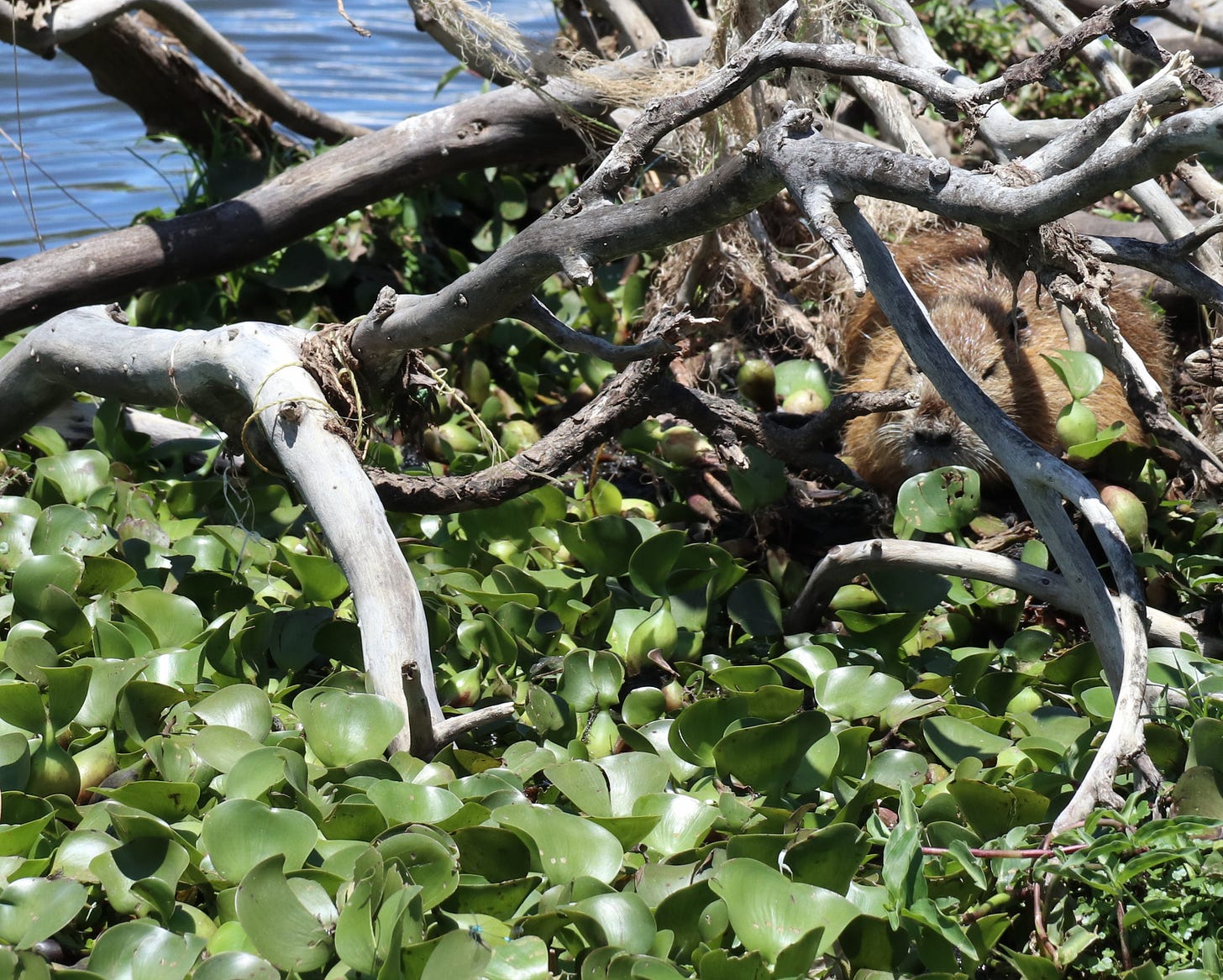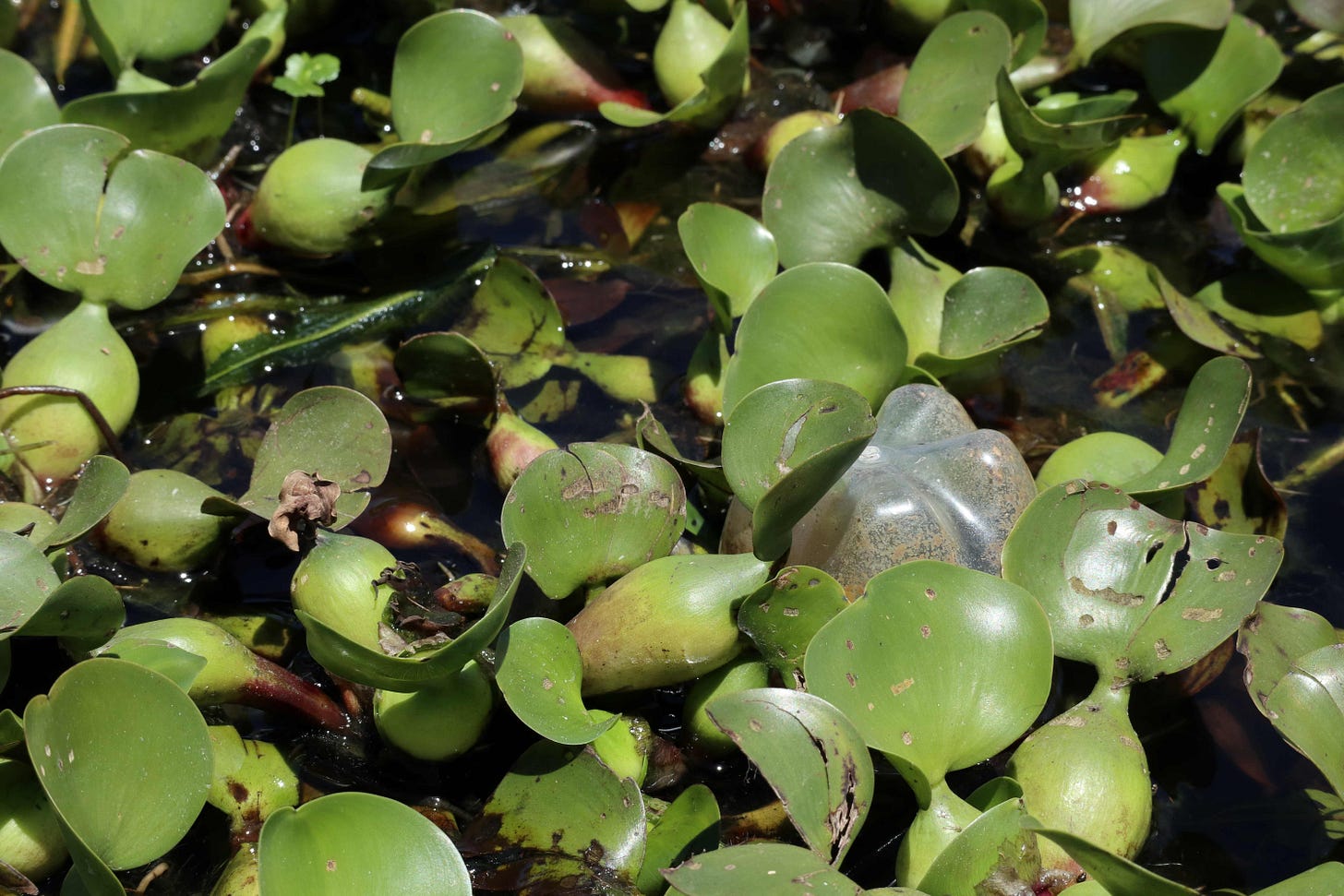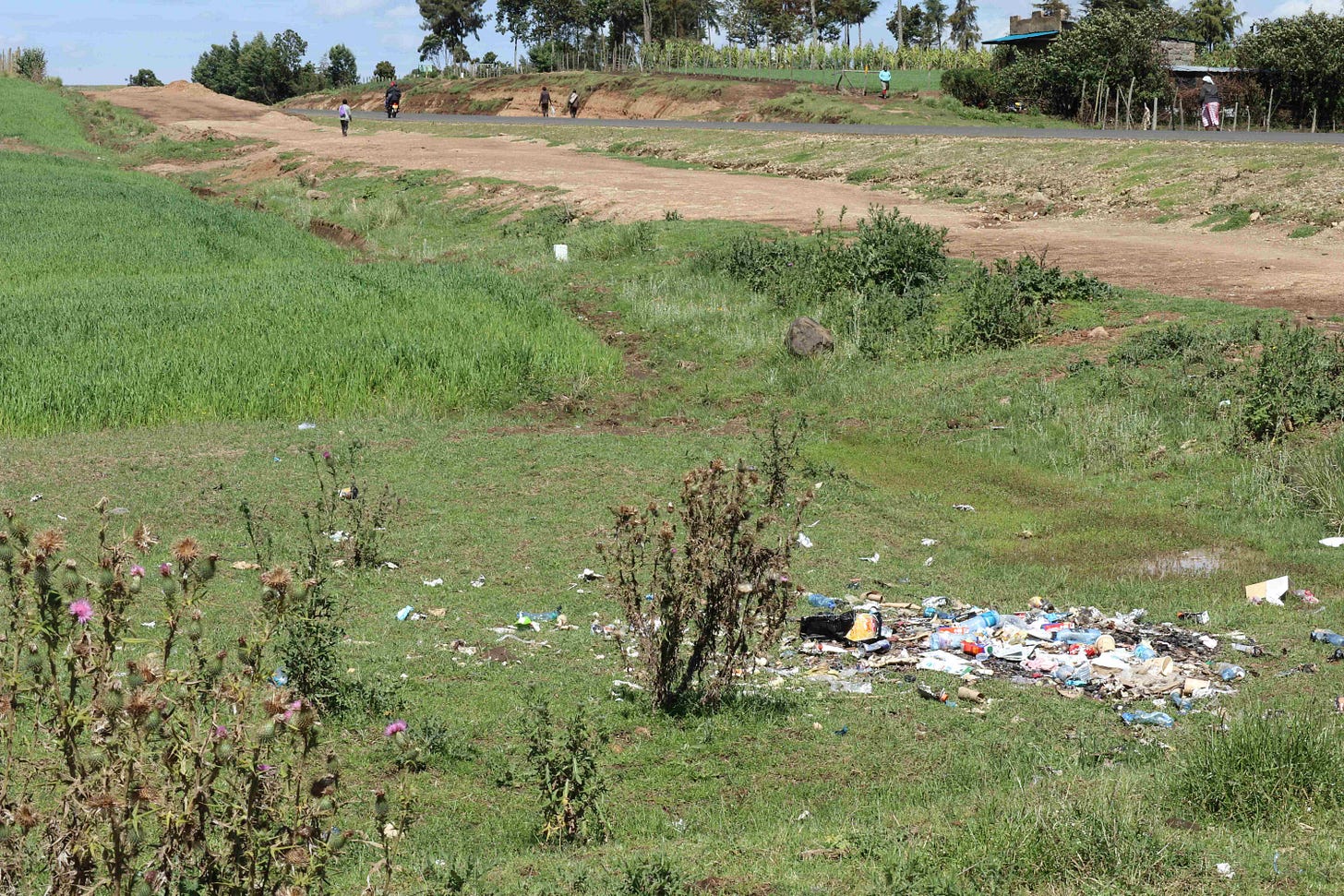I can feel the gentle rocking of the boat as I focus my camera on a patch of water hyacinth floating on the edge of Lake Naivasha. The other seven people in the boat are looking at some small, furry animals, which are hiding at the base of a dead tree branch. I’m not ignoring the animals, but water hyacinth is professionally interesting to me. Among people who have worked on invasive species, it’s notorious. Native to the Amazon, it was spread around the world because of its attractive purple flowers. But it spread from garden ponds into the wild, and in some areas formed huge, floating mats, smothering the waterways. It has a range of negative impacts, such as reducing oxygen levels in the water, preventing the growth of native plants and blocking access to the water for fishing, irrigation and boating. For years, people have been trying to turn a problem into a resource by finding uses for water hyacinth. There have been some successes, such as making compost, furniture or biogas from it, but there always seems to be more of the plant than anyone can use.

My visit to Lake Naivasha was part of a guided tour I did for the final part of my visit to Kenya. It wasn’t quite what I expected – when the tour itinerary mentioned a boat ride I had something a little larger in mind. But it was so much better than I was expecting. Seven of us plus our guide Nixon climbed into a little boat with an outboard motor – it was comfortable, but there was no space for anyone else. There were a few moments of uncertainty, but once we were moving I became absorbed in watching the birds that Nixon was pointing out. We saw Egyptian geese, herons, swallows, fish eagles and a giant kingfisher. There were even hippos, lifting their nostrils out of the water to breath and then sinking beneath the surface again. I was probably the only one looking at the water hyacinth.
But there was something else I spotted among the water hyacinth on this peaceful lake, something ubiquitous on Kenya’s roadsides and waterways – plastic bottles. A few seemed to be soft drink bottles, but most were water bottles. I felt a pang of guilt, because I drank a fair few bottles of water while I was in Kenya. While I put my bottles in the hotel rubbish, I know that’s not the end of the story.
I was aware of waste issues in Kenya even before I left New Zealand, because the tour companies sent me information before I travelled saying that I should take a reusable bottle for water and shouldn’t take any plastic bags. In 2017, Kenya banned single-use plastic bags. In 2020, they went a step further, and banned all single-use plastics including plastic water bottles and straws, in certain areas, such as beaches, parks and reserves.
I was interested to learn more, and found my way to an article discussing what was working and what was not. I looked up the author, Jane Mutheu Mutune, and saw that she described herself as ‘passionate about solid waste management’. She sounded exactly like the kind of person I wanted to speak with.
By the time we talk, over Zoom, I’ve seen enough to know that there’s a lot of waste on Nairobi’s streets and rural areas. Part of the problem, Jane tells me, is that waste collection is unaffordable for many households. “Households can pay US$3 every month, then they can put out their waste and once a month it gets picked up and taken to landfill.” In Wellington, a single council rubbish bag costs NZ$3.50, so the cost in Nairobi doesn’t sound too bad. But in Kenya the average annual income is somewhere around US$2000. Many earn much less.
There’s no separate recycling collection either, Jane says. “Solid waste is currently handled in a very basic, rudimentary manner. You find all kinds of waste unsegregated, mixed with other kinds of waste – diapers, potato peelings, plastic beverage bottles, rotten tomatoes… They take it to landfill, mostly the Dandora dump site, but some unscrupulous operators may leave it on the roadside.”
But just because waste is unsegregated doesn’t mean there’s no recycling. Rubbish pickers operate in dumps like Dandora, collecting anything which might be useful or saleable. The Dandora dump site is a story in itself. In 1996, it was declared to be full, but dumping continues to this day. Various articles on the subject suggest that recycling waste from the Dandora dump site supports 3000 families, although I haven’t found an original source for that figure.
Jane notes that these rubbish pickers make an important contribution to the waste value chain, particularly picking out the plastic and metals. But it’s a brutal existence. They’re exposed to toxins and pollution which cause constant health problems. It’s not a solution, and Jane continues to advocate for Kenyan waste to be separated at source.
Life in a Kenyan rubbish dump: Illness, poverty afflict community | Al Jazeera
But organised waste collection is something that happens in Kenya’s wealthy suburbs, such as Karen, where I spent most of my time when I was in Nairobi. It simply doesn’t happen in many poorer areas, especially in the informal settlements, such as Kibera where most residents live in extreme poverty, earning less than US$2 per day, and unemployment rates are high. “When the slum residents have to make a decision over buy food or pay for waste collection,” Jane points out, “you first go for your basic needs. You buy water. You buy food.” But the improper disposal of solid waste has a disproportionate impact in these settlements. It creates a health hazard and facilitates the spread of mosquito-borne diseases. It clogs up drains and streams, causing sewage-laden water to flood the settlement. A lot of the waste ends up in the Nairobi River, which runs along the southern edge of Kibera.
It made sense, then, for Kenya to try and tackle the problem at its source, by banning plastic bags and restricting some other plastics. And there’s some anecdotal evidence that it’s making a difference in places like Kibera – I found this video where the founder of a school which sits beside a stream talks about the difference the ban has made.
Wastewater and Plastic - Kibera and Kenya’s plastic ban on Vimeo
However, Jane tells me, “we don’t know where we are with compliance, because the monitoring of the ban on plastic in 2017 has not been done”. On the one hand, there are places like the Karura Forest, where my bag was checked to see I wasn’t taking in a plastic bottle. On the other hand, when the hotels gave us packed lunches to take into National Parks for various trips, they included plastic bottles of water. This was completely unnecessary because all the vehicles I travelled in carried clean water and one tour company even offered me a reusable bottle in case I didn’t have one. In general, there wasn’t much sign of litter in the parks, but I did see some, including plastic bottles.
Another thing I noticed was that there didn’t appear to be a culture of people bringing their own bags when shopping. I visited two different shopping malls and was always given a bag of some sort. The bags were paper or non-woven polypropylene, which is robust and reusable, but still plastic. I usually refused the bags, because I carry a re-usable bag with me, but based on the responses of the shop staff, someone bringing their own bag wasn’t the norm.
In New Zealand, we simply accept that providing a rubbish disposal service is a job of local government. Even though I question its affordability for those on the lowest incomes, at least it’s free to put out glass and recyclable plastics (whether that plastic gets recycled is an issue for another time). We certainly have problems with too much waste and waste which ends up in the wrong place, but we are privileged to have a reliable collection service. At times, I forget that – there is so much our central and local governments provide for us which citizens of other countries don’t have.
In Kenya, Jane would like to see a change in attitudes to solid waste, and she believes it should start with education. “School institution can be a good community that can set the pace into recycling, reduction and reuse. But it is not currently done.” And, she tells me, Kenya is working on extended producer responsibility – a system where those creating the waste in the first place are responsible for the entire life cycle of the product. Such an approach would firmly point a finger at the Coca-Cola Corporation, which according the advocacy group Clean Up Kenya is responsible for at least 40% of the plastic soft drink and juice bottles littering Kenya’s streets.
The challenge, though, will be in implementation. “We have very good principles and strategies, we have good laws, but the action is more important”. Indeed, that is the challenge for all of us.







Thanks Melanie, another fascinating piece.
One way to think about it is that plastic is an invasive species, and we can't keep letting it proliferate. Really enjoyed the video about the water in Kibera flowing better after the plastic-bag ban.